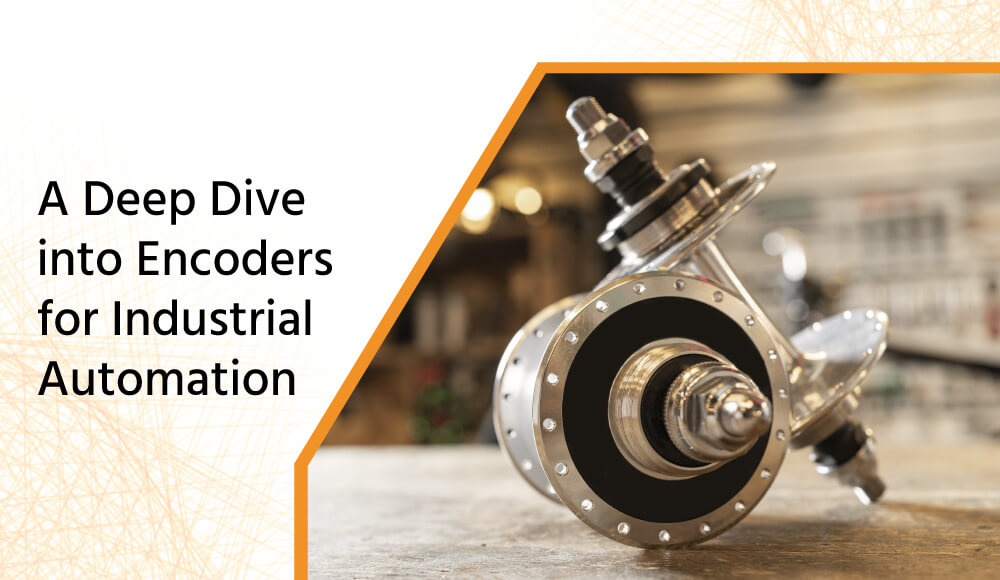
- Vishakha M
- Feb 29, 2024
- Industry
With the advent of industrial automation, different industrial sectors have noticed great improvement. There are numerous benefits of this concept over traditional manual labour.
Automated industrial operations will work rapidly and more accurately compared to human workers. Due to technological advancements, automated devices will operate around the clock without any manual effort. Also, industrial automation will monitor the health status of every piece of equipment and reduce overall waste.
One such invention is an encoder. The device has the ability to convert motion into an electrical signal. This can be effectively read by control device types in a motion control system known as a counter or PLC.
Let’s discuss the encoder in industrial automation in detail.
A] What Are Encoders for Industrial Automation
Encoders are defined as an essential component of various industrial automation processes that result in high-volume and high-speed applications with great accuracy. The industrial encoder has the ability to convert motion into electrical feedback signals, which are further read by a controlling device to measure changes in position, count, direction, speed and linear distance.
Want to know how does an absolute encoder work? Absolute encoders are recognised as feedback devices that offer speed and position information with a digital word. Encoders are used in mechanical and electrical devices that need to operate with precision. The process of controlling and detecting the motor rotation speed and angle with the use of an encoder is known as feedback control.
Wondering what encoders are used for? The encoders are used in various types of technologies in order to create a signal that includes mechanical, resistive, magnetic and optical applications. Optical is the most common, as in this sensing process, the encoder offers feedback based on the light interruption. The encoder tools are majorly used in industrial robots that are specifically used in factories, such as welding robots, assembly robots, machining centres and automatic guided machines for automated processing.
B] Types Of Encoders Used Across Industries
There are two major types of encoders: Linear and Rotary. A linear encoder is used for measuring linear movement, while rotary encoders are designed for measuring rotary movement. The optical linear encoder is the only option for resolutions that are below five microns, while the absolute rotary encoder offers a higher resolution for a maximum of 65,536 pulses per revolution.
1. Linear Encoders
A linear encoder is a sensor or transducer that measures motion along the line or path. It is engineered with a coded scale or strip and a sensing head. The linear encoder will measure the linear movements of an object, such as its speed, displacement, distance, position, direction and acceleration. The optical linear encoders are used in metrology instruments, inkjet printers, motion systems, high-precision machining tools, assembly devices and precision slideways.
2. Rotary Encoders
Want to know what is a rotary encoder? A rotary encoder is also called a shaft encoder. It can convert the angular motion or position of an axle to an analogue. It is the rotary encoder working principle. It is used in different industrial applications that need monitoring and controlling of mechanical devices, including robotics, industrial controls, photographic lenses and computer input devices, for example, optomechanical mice, trackballs, rotating radar platforms and controlled stress rheometers.
C] Automation Applications Of Encoders
1. Registration Mark Timing
For the application of registration mark timing, the response from the encoder will determine the object’s relative position to a known point, which is known as the registration mark. The feedback from the encoder is further used for determining the speed of the moving axis relative to the registration mark.
Mechanically, shaft or measuring wheel encoders will be in the application of registration mark timing. Several mechanical means are used in order to obtain encoder response or feedback from the axis in motion, which includes wheels, chains, gears, belts, or direct action. On the other hand, incremental and absolute encoders are used for registration mark application electrically.
2. Web Tensioning
Web tensioning is known as monitoring and controlling the tension applied to material wounded onto a spool, drum or reel. Encoders are utilised in conjunction with sensors and feedback devices in controlling web tension.
Web tensioning application includes one mounted encoder upon a drive motor and a second mounted encoder to a pinch roller or tensioning roller. These encoders will provide speed data to the controller. In case there are any variations in the motor’s rotation speed and roller, the controller will adjust the drive motor to maintain a constant level of tension.
3. Cut-to-Length
The encoder will generate a number of pulses for cut-to-length applications determining the travel length. When the device sends the number of pulses to the control system, the cutting device will get activated.
In mechanical applications, the thru-bore and shaft encoders are suitable for cut-to-length applications. It will be further applied to the drive motor to advance material to a pinch-roller, a head-roll shaft or a lead screw. In addition, an encoder will measure the wheel assembly to obtain feedback directly from a conveyor surface or the material.
4. Conveying
Incremental encoders are suitable for conveyor applications in tandem and have vision sensors for several operational purposes such as product marking, inspection, and pick up and placing.
The encoder is used for indicating belt speed. The encoder rate pulses are equivalent to the resolution requirements of the device receiving. In general, the encoder supplies pulses to the printer that are equivalent to the lines per inch of print resolution. It will aid in ensuring that the printed image is in the right location on the target that is not compressed or stretched at Pixelwise Technology Pvt. Ltd, we offer automated encoding solutions with various ranges of industrial encoders from certified encoder manufacturers to meet this specific application.
5. Spooling
The material is wound to a spool in spooling applications. When the diameter of the material changes on the supply and take-up spool, it is necessary to maintain the speed of each spool. Here, the encoders will play a major role in providing the motion feedback in order to maintain the speed.
The encoder will also aid in monitoring the material length and help in maintaining the proper tension. It also aids in avoiding breaking, stretching or winding. Measuring wheels, thru-bore or shaft encoders are suitable for these applications based on the system type. The encoders will be helpful to drive pinch rollers, the reel shaft, motors or tension rollers. The integrated encoders are utilised throughout different industrial sectors for level-wind or spooling applications.
Conclusion
This is a complete guide on one of the highly used industrial automation tools – encoders. It is important to understand the types of encoders and their automation applications to invest in the right type. You have to understand your mechanical and electrical automation requirements to purchase the right ones.
Encoders are considered the unsung heroes of precision in various industrial settings. It will offer automated solutions to different challenges and progressing processes in manufacturing. It plays a major role in robotics, CNC machines, automation systems and other industrial applications. It is also used in Motor feedback, Aerospace, Automation, Food and beverage, Material Handling, Medical, Packaging and Printing industries. If you want to make a reliable purchase of encoders, Contact us now!





